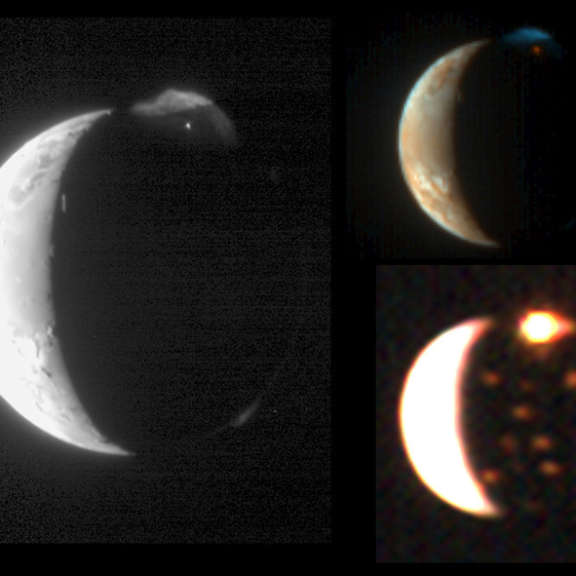All
All
Stories, updates, insights, and original analysis from The Planetary Society.
No plumes? No problem. How Europa Clipper will analyze an icy moon's ocean
Europa doesn't have grandiose plumes like Enceladus. So how will the Clipper mission figure out what's in Europa's ocean?
#AGU17: Spherical harmonics, gravity, and the depth of winds at Jupiter
Results from the Juno gravity science experiment presented at last week's American Geophysical Union meeting suggest Jupiter's winds penetrate only to 3000 kilometers deep.
#AGU17: JunoCam science
JunoCam may be an outreach instrument, but its superb photos of storms on Jupiter are providing plenty of data for scientists to talk about.
Brief note from #AGU17: Juno observes volcanism on Io
At the American Geophysical Union meeting, members of the Juno team showed observations of active volcanism on Jupiter's moon Io.
Clipper Slipper
Will NASA's Space Launch System be ready to launch a Europa mission in 2022?
Cassini’s Last Dance With Saturn: The Farewell Mosaic
Amateur image processor Ian Regan shares the story of processing Cassini's final images of the ringed planet.
Fall 2017 issue of The Planetary Report now available
The Fall 2017 issue of The Planetary Report is in the mail and available online now to our members!
Cassini: The dying of the light
Cassini is no more. At 10:31 according to its own clock, its thrusters could no longer hold its radio antenna pointed at Earth, and it turned away. A minute later, it vaporized in Saturn’s atmosphere. Its atoms are part of Saturn now.
What to expect during Cassini's final hours
A timeline of what to expect from the great mission during its final hours.
And then there was one
The end of the Cassini mission is a harbinger for a looming gap in outer planets exploration missions.
Voyager 40th Anniversary: Summer of '79
Planetary scientist Paul Schenk shares his story of working on the Voyager missions as a JPL intern back in 1979.
Voyager 40th anniversary: Reflecting on the pale blue dot
Today is the 40th anniversary of the launch of Voyager 1. Four decades later, both spacecraft survive, still producing science, still working on their interstellar missions. On the occasion of the anniversary, we revisit Carl Sagan's reflections on the significance of the Voyager missions.
Voyager 40th anniversary: Revisiting the Voyagers' planetary views
Björn Jónsson argues that even now, 40 years after Voyager 1 and 2 were launched, a lot of the data they returned is still of high interest.
Voyager 40th Anniversary: Watching an Alien World Turn
In 1979, both Voyager missions captured thousands of photos of Jupiter as frames of movies of the giant planet spinning among its moons. In honor of the mission's 40th launch anniversary, Ian Regan has reprocessed the data to produce stunning new movies.
Voyager 40th anniversary: The Planetary Report's chronicles
In honor of the 40th anniversary of the Voyager missions, we're making publicly available seven back issues of The Planetary Report that chronicled the grand tour of the giant planets.
Voyager 40th anniversary: The transformation of the solar system
The Voyager missions transformed most of the large worlds of the solar system from points of light into places to be explored.
Celebrating the 40th anniversaries of the Voyager launches
Sunday, August 20 marks the 40th anniversary of the launch of Voyager 2. Tuesday, September 5, will be the 40th anniversary for Voyager 1. Throughout the next three weeks, we'll be posting new and classic material in honor of the Voyagers. Here's a preview.
In total eclipse of a star, New Horizons' future flyby target makes its presence known
The team reported two weeks ago that the first attempts at observing 2014 MU69 were unsuccessful. But in their third try, on July 17, astronomers in Argentina saw the telltale sign of MU69's presence: a stellar wink.
Congress gives NASA's planetary science division some love (and a Mars orbiter)
The House of Representatives proposed $2.1 billion for NASA's planetary science budget, which would be an all-time high. Part of the increase would be used to start work on a new reconnaissance and communications orbiter.
A guide to Cassini's remaining orbits
Sadly, the Cassini mission ends soon. We're halfway through the


 Explore Worlds
Explore Worlds Find Life
Find Life Defend Earth
Defend Earth


 Sun
Sun Mercury
Mercury Venus
Venus Earth
Earth Mars
Mars Jupiter
Jupiter Saturn
Saturn Uranus
Uranus Neptune
Neptune Small Bodies
Small Bodies















